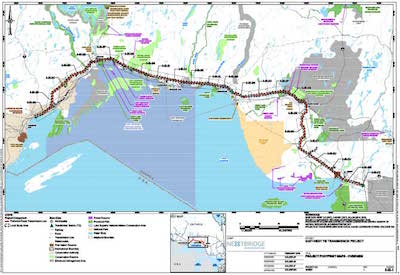Northern Ontario Leaders Urge Province to Proceed Now with East-West Tie Transmission Project

Oct 15, 2018
Leaders from Northern Ontario First Nations and Municipalities have called on Ontario to proceed without further delay on the multi-million-dollar East-West Tie transmission project.
“Northern Ontario communities are seriously concerned about the ongoing delays and lack of decision-making by Ontario related to the East-West Tie,” says Chief Matthew Dupuis of Red Rock Indian Band. “This is a shovel-ready project that needs to move forward to prevent job and investment losses in our region. Hundreds of Northern Ontarians have been trained and are now ready to work on this construction project, but are starting to question their employment potential and futures in the region once again. We are calling for strong provincial leadership to get this project moving for Ontario.”
The proposed new East-West Tie Transmission Project would involve installing a double-circuit 230 kilovolt (kV) transmission line generally paralleling the existing double-circuit 230 kV transmission corridor (the existing East-West Tie) connecting the Wawa Transformer Station (TS) to the Lakehead TS near Thunder Bay, with a connection approximately midway at the Marathon TS. The preferred route is approximately 450 km long and would avoid some sensitive features crossed by the existing line.
The former provincial government allowed Hydro One to submit a proposal at the final hour. Until this point, the project had been on schedule, and NextBridge Infrastructure won the bid through a fair, open and transparent process. In August 2013, NextBridge was designated by the Ontario Energy Board to develop the EWT line and to file a Leave to Construct application.
Over 18 First Nations and several cities and towns between Wawa and Thunder Bay have invested time and resources to prepare for the proposed fall 2018 construction date. This work includes developing detailed construction and environmental plans for the transmission line that minimize town centre and parkland intrusions, as well as in-service schedules to support additional economic development plans.
The East-West Tie was included as a priority project in the Government of Ontario’s 2010 Long Term Energy Plan. The project would ensure a long-term, reliable supply of electricity Northwestern Ontario. Industrial activities in the northwest, particularly in the mining sector, are expected to drive strong electricity demand growth in the coming decade.
Find out more about the project: http://www.nextbridge.ca/project_info
Image source: NextBridge










![Guide to the Canadian Electrical Code, Part 1 – 26th Edition[i] – A Road Map: Section 54](https://electricalindustry.ca/wp-content/uploads/2022/11/Guide-CE-Code-2.png)





